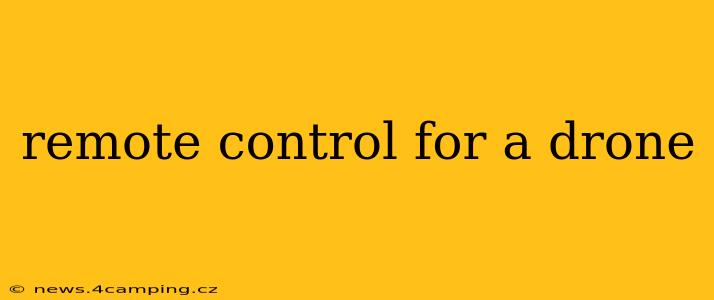Decoding the World of Drone Remote Controls: A Comprehensive Guide
Drones have revolutionized various industries, from aerial photography and videography to agriculture and infrastructure inspection. But behind every smooth flight and stunning aerial shot lies a sophisticated piece of technology: the drone remote control. This guide delves into the intricacies of drone remotes, exploring their functionalities, types, and key considerations for both beginners and experienced pilots.
What is a Drone Remote Control?
A drone remote control, also known as a transmitter, is the handheld device used to pilot and control a drone. It acts as the communication link between the pilot and the Unmanned Aerial Vehicle (UAV), transmitting commands for flight maneuvers, camera operations, and other drone functions. These commands are typically sent via radio waves, although some advanced systems utilize other communication protocols.
What are the Different Types of Drone Remote Controls?
Drone remotes vary significantly in features and capabilities, catering to different needs and skill levels.
-
Basic Controllers: These are typically smaller, simpler devices found with entry-level consumer drones. They offer basic flight controls like ascent, descent, yaw, pitch, and roll, along with simple camera control options.
-
Advanced Controllers: These remotes are more robust and feature-rich, often boasting multiple joysticks, customizable buttons, and integrated screens displaying telemetry data (such as battery level, GPS coordinates, and altitude). They often come paired with more sophisticated drones and allow for greater control and precision.
-
Modular Controllers: Some manufacturers offer modular controllers, allowing users to customize the layout and functionality of their remotes by adding or removing components. This flexibility ensures the controller adapts to the specific needs of the pilot and drone.
What are the Key Features to Look For in a Drone Remote Control?
Choosing the right drone remote control is crucial for a positive flying experience. Here are some critical features to consider:
-
Range: The distance the controller can communicate with the drone is crucial. Longer ranges allow for more adventurous flights.
-
Frequency: Different remotes operate on different frequencies, ensuring minimal interference. It's important to ensure your remote and drone are compatible.
-
Ergonomics: A comfortable and intuitive design is paramount for extended flights. Consider the size, weight, and button placement.
-
Channels: The number of channels determines the number of functions the remote can control simultaneously. More channels often mean greater control and precision.
-
Screen Integration: Some advanced controllers feature integrated screens that display real-time telemetry data.
How does a Drone Remote Control Work?
A drone remote control transmits signals to the drone using radio waves. The drone's receiver interprets these signals and executes the commands sent by the pilot. The specific communication protocols vary depending on the drone and remote manufacturer. The process is typically highly secure, preventing unauthorized access and control.
Can I use any Remote Control with any Drone?
No. Drone remotes and drones are designed to work together. Using an incompatible remote could lead to malfunction, loss of control, and potentially damage to the drone or surrounding environment. Always use the remote control supplied with your drone or a compatible alternative specifically designed for your drone model.
What are Some of the Best Drone Remote Controls Available?
Specific models and brands are constantly evolving, and recommendations change rapidly. Research current reviews from reputable sources before making a purchase. Consider the type of drone you have or plan to purchase and choose a compatible and appropriately featured remote control.
How do I maintain my Drone Remote Control?
Proper maintenance is crucial for longevity and reliable performance. Keep the remote clean, avoid exposing it to extreme temperatures or moisture, and replace batteries according to the manufacturer's recommendations. Regularly check for any signs of damage and address them promptly.
This guide provides a solid foundation for understanding drone remote controls. Remember to always consult your drone's manual and prioritize safety when operating your drone. Happy flying!
